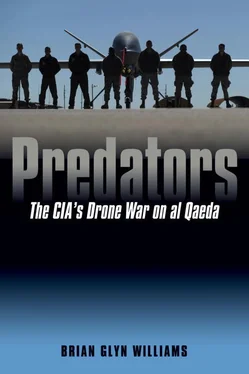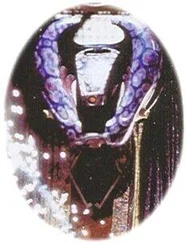It also allowed the soon-to-be insurgent leader Gulbuddin Hekmatyar to return to the country. Hekmatyar, as mentioned previously, was the notorious fundamentalist mujahideen leader who had made a name for himself by throwing acid into the faces of unscarved women in Kabul, shelling the Afghan capital in the 1990s, and turning against his American sponsors during the 1991 Gulf War. In 1997 this Pashtun fundamentalist had been driven into exile in Iran by the Taliban, but in February 2002 he secretly returned to his old jihad stomping grounds in eastern Afghanistan. There he and his followers declared jihad on the American “infidels.”
In May 2002 the CIA tracked Hekmatyar to a base in the forested mountains of Kunar Province on Afghanistan’s northeastern border with Pakistan. There a CIA drone launched its Hellfire missiles at him and his followers. According to news reports, the missiles killed several of Hekmatyar’s followers but failed to take out the leader himself. 3From this point forward Hekmatyar is said to have changed “his location every five minutes” to avoid the drones. 4The United States suspected that one of the locations Hekmatyar hid in was the FATA, a region he had used as a rear-area staging ground during the 1980s jihad against the Soviets.
Hekmatyar was not, however, the only ex-mujahideen warlord to ally himself with the Taliban as they licked their wounds in 2002 and prepared to launch an insurgency in the Pashtun belt of southeastern Afghanistan. The former CIA-backed mujahideen leader Jalaludin Haqqani had been courted by the CIA in 2001, but Haqqani saw the world in Manichean black and white jihad terms. To him the Americans were infidel invaders who needed to be expelled from Afghanistan just as the Soviets had been before them. As the American bombs fell in Operation Enduring Freedom, Haqqani and his followers fled from their base in the eastern Afghan province of Khost over the border into the neighboring Pashtun FATA tribal agency of North Waziristan. Haqqani had been based in this area during the 1980s, and he knew it well. There the so-called Haqqani Network regrouped in 2002 and awaited orders from its nominal leader, Mullah Omar. There were thus three Pashtun terrorist-insurgent networks, not including al Qaeda, based in the FATA and preparing to launch an insurgency against the Americans, who had too few troops to control this vast area of Afghanistan. Fortunately for the Taliban and al Qaeda, America’s attention was about to be directed elsewhere—and America was about to snatch defeat from the jaws of victory.
As the Taliban and its allies regrouped in the FATA, the United States’ attention began to be diverted toward the Iraqi ruler, Saddam Hussein. As early as February 2002 the United States began preparations for a massive invasion of Socialist-Baathist Iraq, which was said to have dangerous weapons of mass destruction. The head of U.S. Central Command (CENTCOM), Gen. Tommy Franks, summed up this redirection of NSA satellites, special operations troops, and Predator drones from Afghanistan to Iraq as follows: “We have stopped fighting the war on terror in Afghanistan. We are moving military and intelligence personnel and resources out of Afghanistan to get ready for a future war in Iraq.” Franks described the downgraded mission in Afghanistan, a conflict that would soon become known as the “forgotten war,” as a “manhunt.” 5Eventually 75 percent of U.S. drones would be transferred from Afghanistan to the new theater of action in Iraq. 6
Shortly after the Iraq War started, one U.S. official said, “If we were not in Iraq, we would have double or triple the number of Predators across Afghanistan, looking for Taliban and peering into the tribal areas. We were simply in a world of limited resources, and those resources are in Iraq. Anyone who tells you differently is blowing smoke.” 7
In a fascinating incident in 2002, one of the newly transferred Predators entered an impromptu dogfight with an Iraqi MiG 25 Foxbat fighter plane. This was the first incident in which a UAV waged combat against a manned aircraft. Unfortunately for the drone, the faster-flying MiG jet fighter easily shot down the slow-moving Predator. The last thing the drone’s remote pilots saw on their screens back in the United States was a missile shooting toward their aircraft as their own missile streaked toward the oncoming MiG. Then the screen went blank as the MiG’s missile hit and destroyed the Predator. 8
But the Predator’s major headlines in 2002 came not from the new war in Iraq but from Yemen, where one of America’s chief al Qaeda enemies, Qaed Senan al Harethi, known as the “Godfather of Terror,” was planning terrorist attacks on the United States. 9Harethi had been a wanted man ever since 2000, when he had helped plot the al Qaeda bombing of the USS Cole , which killed seventeen sailors. The U.S. government had requested that the Yemeni government arrest Harethi, and so the Yemenis sent their troops to capture Harethi, who was living in the Marib region of Yemen with allied tribes. But the arrest attempt ended in disaster as Harethi’s tribal allies fought back and killed eighteen Yemeni police. 10This incident vividly demonstrated the limitations of trying to arrest terrorists in remote tribal regions where the writ of the government is not recognized. Similar calls for the CIA to arrest suspected al Qaeda and Taliban terrorists in the remote tribal regions of Pakistan overlook the impossibility of penetrating these regions and arresting militants among thousands of their armed supporters.
Having failed to arrest Harethi, the CIA tried tracking him down using a Predator drone based in the French-garrisoned country of Djibouti as part of Combined Joint Task Force–Horn of Africa. The U.S. ambassador in Yemen also paid off some local tribesmen to keep track of Harethi’s movements. 11This two-tracked policy paid dividends on November 4, 2002, when the NSA’s Yemen-based Cryptological Support Group tracked Harethi down by monitoring his cell phone. The NSA told the CIA, “Here’s the general location…. We have the satellite phone, now go get the guy.” 12
A patrolling drone was rushed to the scene and spotted Harethi’s vehicle. As Harethi and his compatriots made their way out into the desert, their SUV was suddenly hit with a powerful Hellfire missile that carried enough explosives to destroy a tank. Everyone inside was instantly incinerated. According to one report, all that remained of the travelers was “a mass of carbonized body parts.” 13Harethi’s body was identified by a distinctive mark found on his dismembered leg.
But that was not all. It was later discovered that the CIA had killed two birds with one stone, for one of Harethi’s companions was found to be none other than Kemal Darwish, the head of an al Qaeda sleeper cell based in Lackawana, New York. It so happened that Darwish was a naturalized U.S. citizen, which meant that the CIA had executed an American without providing him with a trial. U.S. government officials later claimed that they had not known in advance that Darwish was in the SUV, but as one official dryly put it, “it would not have made a difference. If you’re a terrorist, you’re a terrorist.” 14
The U.S. government’s views on the assassination had clearly come a long way since George Tenet’s cautious approach on the eve of 9/11, and this did not go unnoticed. The killing of an American citizen by the CIA raised eyebrows, as did the killing of a Yemeni citizen on Yemeni soil by a foreign intelligence agency. In many ways the Yemeni reaction to the targeted killing of two terrorists and their compatriots provided a foretaste of the reaction to the Americans’ more systematic campaign of drone assassinations in Pakistan’s remote tribal zones. Although the CIA’s operations to kill Harethi had had the tacit approval of the Yemeni government, the actual drone strike had been carried out unilaterally. Some members of the Yemeni government expressed unease with the way the CIA had acted on their soil and the opposition parties howled in protest about the violation of Yemen’s sovereignty.
Читать дальше












